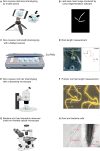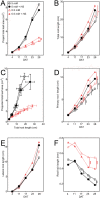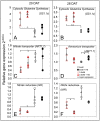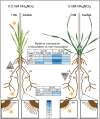N-dependent dynamics of root growth and nitrate and ammonium uptake are altered by the bacterium Herbaspirillum seropedicae in the cereal model Brachypodium distachyon
- PMID: 35512445
- PMCID: PMC9440436
- DOI: 10.1093/jxb/erac184
N-dependent dynamics of root growth and nitrate and ammonium uptake are altered by the bacterium Herbaspirillum seropedicae in the cereal model Brachypodium distachyon
Abstract
Nitrogen (N) fixation in cereals by root-associated bacteria is a promising solution for reducing use of chemical N fertilizers in agriculture. However, plant and bacterial responses are unpredictable across environments. We hypothesized that cereal responses to N-fixing bacteria are dynamic, depending on N supply and time. To quantify the dynamics, a gnotobiotic, fabricated ecosystem (EcoFAB) was adapted to analyse N mass balance, to image shoot and root growth, and to measure gene expression of Brachypodium distachyon inoculated with the N-fixing bacterium Herbaspirillum seropedicae. Phenotyping throughput of EcoFAB-N was 25-30 plants h-1 with open software and imaging systems. Herbaspirillum seropedicae inoculation of B. distachyon shifted root and shoot growth, nitrate versus ammonium uptake, and gene expression with time; directions and magnitude depended on N availability. Primary roots were longer and root hairs shorter regardless of N, with stronger changes at low N. At higher N, H. seropedicae provided 11% of the total plant N that came from sources other than the seed or the nutrient solution. The time-resolved phenotypic and molecular data point to distinct modes of action: at 5 mM NH4NO3 the benefit appears through N fixation, while at 0.5 mM NH4NO3 the mechanism appears to be plant physiological, with H. seropedicae promoting uptake of N from the root medium.Future work could fine-tune plant and root-associated microorganisms to growth and nutrient dynamics.
Keywords: Brachypodium; Herbaspirillum seropedicae; Agriculture; EcoFAB; N fixation; cereals; crop productivity; nitrogen; non-invasive phenotyping; plant-growth promoting rhizobacteria; wheat.
© The Author(s) 2022. Published by Oxford University Press on behalf of the Society for Experimental Biology.
Figures









Similar articles
-
Differential growth responses of Brachypodium distachyon genotypes to inoculation with plant growth promoting rhizobacteria.Plant Mol Biol. 2016 Apr;90(6):689-97. doi: 10.1007/s11103-016-0449-8. Epub 2016 Feb 13. Plant Mol Biol. 2016. PMID: 26873699
-
Importance of Poly-3-Hydroxybutyrate Metabolism to the Ability of Herbaspirillum seropedicae To Promote Plant Growth.Appl Environ Microbiol. 2019 Mar 6;85(6):e02586-18. doi: 10.1128/AEM.02586-18. Print 2019 Mar 15. Appl Environ Microbiol. 2019. PMID: 30610076 Free PMC article.
-
RNA-seq analyses reveal insights into the function of respiratory nitrate reductase of the diazotroph Herbaspirillum seropedicae.Environ Microbiol. 2016 Sep;18(8):2677-88. doi: 10.1111/1462-2920.13422. Epub 2016 Jul 12. Environ Microbiol. 2016. PMID: 27322548
-
Brachypodium: a promising hub between model species and cereals.J Exp Bot. 2014 Oct;65(19):5683-96. doi: 10.1093/jxb/eru376. J Exp Bot. 2014. PMID: 25262566 Review.
-
Azospirillum, a free-living nitrogen-fixing bacterium closely associated with grasses: genetic, biochemical and ecological aspects.FEMS Microbiol Rev. 2000 Oct;24(4):487-506. doi: 10.1111/j.1574-6976.2000.tb00552.x. FEMS Microbiol Rev. 2000. PMID: 10978548 Review.
Cited by
-
Plant Growth Promotion and Heat Stress Amelioration in Arabidopsis Inoculated with Paraburkholderia phytofirmans PsJN Rhizobacteria Quantified with the GrowScreen-Agar II Phenotyping Platform.Plants (Basel). 2022 Oct 30;11(21):2927. doi: 10.3390/plants11212927. Plants (Basel). 2022. PMID: 36365381 Free PMC article.
-
Multiomic Approaches Reveal Hormonal Modulation and Nitrogen Uptake and Assimilation in the Initial Growth of Maize Inoculated with Herbaspirillum seropedicae.Plants (Basel). 2022 Dec 22;12(1):48. doi: 10.3390/plants12010048. Plants (Basel). 2022. PMID: 36616175 Free PMC article.
-
Nitric oxide synthase expression in Pseudomonas koreensis MME3 improves plant growth promotion traits.Appl Microbiol Biotechnol. 2024 Feb 15;108(1):212. doi: 10.1007/s00253-024-13029-1. Appl Microbiol Biotechnol. 2024. PMID: 38358431 Free PMC article.
-
Studying root-environment interactions in structured microdevices.J Exp Bot. 2023 Jul 18;74(13):3851-3863. doi: 10.1093/jxb/erad122. J Exp Bot. 2023. PMID: 37042515 Free PMC article.
-
RhizoNet segments plant roots to assess biomass and growth for enabling self-driving labs.Sci Rep. 2024 Jun 5;14(1):12907. doi: 10.1038/s41598-024-63497-8. Sci Rep. 2024. PMID: 38839814 Free PMC article.
References
-
- Arsova B, Foster KJ, Shelden MC, Bramley H, Watt M.. 2020. Dynamics in plant roots and shoots minimize stress, save energy and maintain water and nutrient uptake. New Phytologist 225, 1111–1119. - PubMed
-
- Boot RG, Mensink M.. 1990. Size and morphology of root systems of perennial grasses from contrasting habitats as affected by nitrogen supply. Plant and Soil 129, 291–299.
-
- Bundesministerium der justiz und für Verbraucherschutz. 2017. Verordnung über die Anwendung von Düngemitteln, Bodenhilfsstoffen, Kultursubstraten und Pflanzenhilfsmitteln nach den Grundsätzen der guten fachlichen Praxis beim Düngen (Düngeverordnung – DüV).https://www.gesetze-im-internet.de/d_v_2017/D%C3%BCV.pdf
Publication types
MeSH terms
Substances
Supplementary concepts
Grants and funding
LinkOut - more resources
Full Text Sources
Molecular Biology Databases

